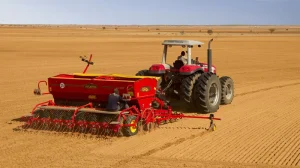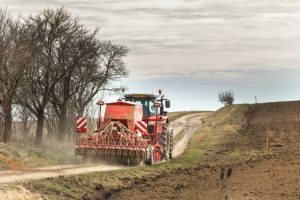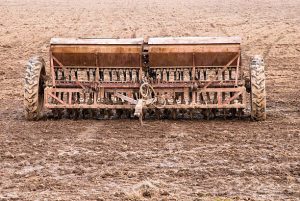Seed drills are often used for planting corn, although they are not as common as planters. Seed drills typically meter seeds at a lower rate than planters, which can be advantageous for some corn planting applications. For example, seed drills may be used to plant silage corn, which is typically planted at a higher density than grain corn.
types of seed drill for corn
There are two main types of seed drills:
plate seed drills:
Plate seed drills use a series of plates with holes or indentations to meter the seeds.

brush seed drills:
Brush seed drills use brushes to simulate the seeds.
Seed drills can be mounted on tractors or be pulled behind them. They can also be equipped with a variety of attachments, such as fertilizer applicators and row markers.

Here are some of the advantages of using a seed drill for corn:
- Seed drills can plant corn at a lower rate than planters, which can save money on seed costs.
- Seed drills can be used to plant corn in no-till fields, which can improve soil health.
- Seed drills can be used to plant corn in cover crops, which can help suppress weeds and improve soil fertility.
Here are some of the disadvantages of using a seed drill for corn:
- Seed drills may not be as accurate as planters at placing seeds at the correct depth and spacing.
- Seed drills may not be as effective as planters at planting corn in wet or cold soil.
- Seed drills may not be as versatile as planters, which can be used to plant a variety of crops
Seed Drills for Soybeans: Precision Planting at Your Fingertips
Seed drills are becoming increasingly popular for planting soybeans, offering several advantages over traditional broadcasting methods. They provide precise seed placement, consistent depth control, and efficient use of seeds, which can ultimately lead to higher yields and reduced costs.
Types of Seed Drills:
-
Plate Seed Drills:
These use rotating plates with indentations to accurately meter and singulate seeds before dropping them into the furrow. They’re well-suited for soybeans and other round seeds.
-
Brush Seed Drills:
These utilize brushes to gently guide and space seeds, ideal for irregular-shaped seeds like corn or beans.
Benefits of Using Seed Drills for Soybeans:
-
Precision Planting:
- Accurate seed spacing optimizes plant distribution, promoting proper light interception, nutrient uptake, and weed control.
-
Consistent Depth Control:
- Seeds are placed at the desired depth, ensuring optimal germination and emergence, even in uneven soil conditions.
-
Reduced Seed Costs:
- Precise placement minimizes seed waste and ensures efficient use of valuable soybean seeds.
-
Improved Crop Emergence:
- Uniform depth and spacing lead to even emergence, creating a strong, competitive stand.
-
Faster Planting Speeds:
- Modern seed drills can operate at higher speeds compared to traditional methods, saving time and labor.
Choosing the Right Seed Drill:
Several factors come into play when selecting a seed drill for your soybean operation:
-
Farm Size and Budget:
Consider the size of your fields and budget constraints when choosing the drill size and complexity.
-
Soil Conditions:
Opt for drills suitable for your specific soil type and tillage practices.
-
Soybean Variety:
Choose a drill compatible with the seed size and shape of your chosen soybean variety.
-
Desired Features:
Look for features like fertilizer application capabilities, row markers, and adjustable settings for optimal performance.
Safety First:
When operating any farm machinery, prioritizing safety is crucial. Always follow the manufacturer’s instructions and safety guidelines, wear appropriate protective gear, and be mindful of bystanders and potential hazards.
By utilizing seed drills for soybean planting, you can achieve precise, efficient, and productive results, contributing to a successful and sustainable farming operation.
Planting Peanuts with Precision: Seed Drills for the Job
Peanuts are a valuable crop, and ensuring a successful harvest starts with proper planting. Seed drills can be a game-changer for peanut farmers, offering accurate seed placement, consistent depth control, and improved efficiency compared to traditional methods.
Types of Seed Drills for Peanuts
-
Plate Seed Drills:
- These work well for round seeds like peanuts. Plates with precisely sized indentations meter and stimulate the seeds before dropping them into the furrow.
-
Brush Seed Drills:
While less common for peanuts, brush drills can be suitable for some varieties. Brushes gently guide and space the seeds, potentially useful for irregularly shaped peanut types.
Benefits of Using Seed Drills for Peanuts:
- Precise Seeding: Accurate spacing optimizes plant distribution, leading to better light interception, nutrient uptake, and weed control.
- Consistent Depth Control: Seeds are placed at the desired depth, promoting uniform germination and emergence, crucial for peanut yields.
- Reduced Seed Waste: Precise placement minimizes seed waste and ensures efficient use of valuable peanut seeds.
- Improved Crop Emergence: Uniform depth and spacing contribute to even emergence, creating a strong and competitive peanut stand.
- Faster Planting Speeds: Modern seed drills can operate at higher speeds compared to manual planting, saving time and labor.
Choosing the Right Seed Drill for Peanuts:
Several factors play a role in selecting the ideal seed drill for your peanut operation:
- Farm Size and Budget: Consider the size of your fields and budget constraints when choosing the drill size and complexity.
- Soil Conditions: Opt for drills suitable for your specific soil type and tillage practices.
- Peanut Variety: Choose a drill compatible with the seed size and shape of your chosen peanut variety.
- Desired Features: Look for features like fertilizer application capabilities, row markers, and adjustable settings for optimal performance.
Safety First:
Remember, operating farm machinery requires prioritizing safety. Always follow the manufacturer’s instructions and safety guidelines, wear appropriate protective gear, and be mindful of bystanders and potential hazards.
By utilizing seed drills for peanut planting, you can achieve precise, efficient, and productive results, contributing to a successful and sustainable peanut harvest. Remember, proper maintenance and calibration of your seed drill are essential for ensuring optimal performance and seed placement accuracy. With careful consideration and responsible operation, seed drills can be a valuable asset for any peanut farmer.
for more crops sowing by this:
Seed drills are versatile tools used for planting a wide range of crops beyond corn, soybeans, and peanuts. Here are some additional crops commonly sown using seed drills:
Small Grains:
- Wheat: Seed drills ensure the precise placement of wheat seeds at the desired depth, leading to uniform emergence and improved yields.
- Barley: Similar to wheat, seed drills offer accurate planting and depth control for barley, maximizing germination and yield potential.
- Oats: Seed drills are well-suited for planting oats, particularly in colder climates where consistent depth control is crucial for successful germination.
Legumes:
- Peas: Seed drills provide accurate spacing and depth control for pea seeds, promoting optimal plant growth and pod development.
- Beans: From lentils to chickpeas, seed drills can be used for various bean varieties, ensuring proper spacing and depth for uniform emergence and yield.
Oilseeds:
- Canola: Seed drills offer precise placement of canola seeds at the desired depth, leading to optimal germination and establishment.
- Sunflower: Seed drills can be used for planting sunflowers, ensuring proper spacing and depth for even emergence and maximum seed production.
Other Crops:
- Sorghum: Seed drills are suitable for planting sorghum, offering accurate seed placement and depth control for consistent emergence and vigorous growth.
- Cotton: In some regions, seed drills are used for cotton planting, providing precise seed placement and depth control for optimal germination and establishment.
Advantages of using seed drills for these crops:
- Precision planting: Ensures proper spacing and depth, leading to improved germination, emergence, and yield.
- Efficient seed use: Minimizes seed waste compared to broadcasting methods.
- Faster planting speeds: Saves time and labor compared to manual planting.
- Reduced soil erosion: Precise placement minimizes soil disturbance compared to broadcasting.
The specific type of seed drill used for each crop depends on factors like seed size, shape, and desired planting depth. When choosing a seed drill, consider your specific needs and the crops you intend to plant.
Conclusion:
Corn, soybeans, and peanuts represent three pillars of agriculture, each with unique needs and challenges. However, they share a common ground in the benefits offered by seed drills. When planted with these innovative tools, all three crops flourish due to:
- Precise Seeding: Seeds are placed at optimal spacing and depth, leading to improved germination, uniform emergence, and ultimately, higher yields.
- Increased Efficiency: Seed drills minimize seed waste and planting time, allowing farmers to work smarter and optimize their operations.
- Sustainable Practices: Precision planting reduces soil disturbance and promotes resource conservation, contributing to a more sustainable agricultural future.
In essence, seed drills offer a win-win scenario for both farmers and their crops. They ensure optimal growth, maximize production, and pave the way for a more efficient and sustainable agricultural landscape.
FAQs for Seed Drills and Planting Corn, Soybeans, and Peanuts
General:
- What are the main types of seed drills?
- Plate and brush drills are the most common, each suited for different seed sizes and shapes.
- What factors should I consider when choosing a seed drill?
- Farm size, budget, soil conditions, specific crops, and desired features like fertilizer application.
- How do seed drills improve crop yields?
- Precise placement, consistent depth control, and efficient seed use contribute to better germination, emergence, and plant growth, leading to higher yields.
For Corn:
- Is a seed drill always the best option for planting corn?
- Planters are more common for corn, but seed drills can be advantageous for silage corn or no-till planting.
- What are the challenges of using a seed drill for corn?
- Ensuring accurate depth and spacing in cold or wet soil and potentially lower planting speeds compared to planters.
For Soybeans:
- Why are seed drills becoming increasingly popular for soybeans?
- They offer precise planting, consistent depth control, and reduced seed costs compared to traditional methods.
- What are some important considerations when choosing a seed drill for soybeans?
- Choose a drill compatible with your specific soybean variety and desired planting depth.
For Peanuts:
- Are seed drills effective for all types of peanuts?
- They are well-suited for round-seeded varieties, but brush drills might be suitable for some irregular shapes.
- What are the key benefits of using a seed drill for peanuts?
- Precise spacing ensures optimal light and nutrient uptake, leading to stronger plants and higher yields.






